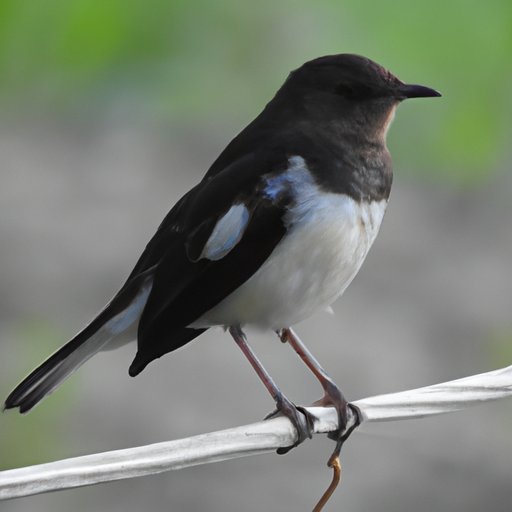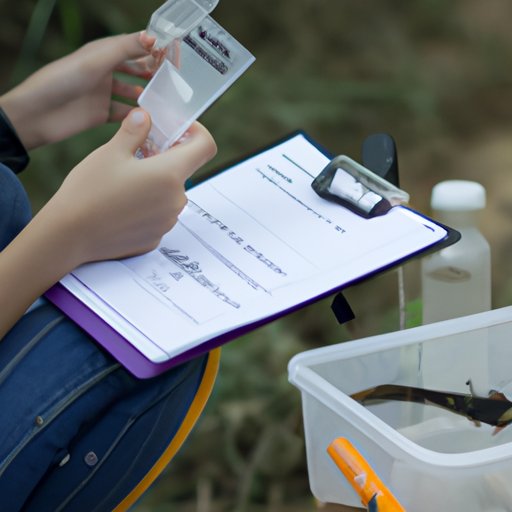Introduction
Bird watching is an increasingly popular hobby for nature enthusiasts all over the world. Millions of people take part in bird watching every year, from amateur beginners to experienced experts. Whether you’re a student looking to learn more about the natural world or a retiree wanting to spend some time outdoors, bird watching is an excellent way to explore the outdoors and observe wildlife up close.
In this article, we’ll cover the basics of bird watching and provide helpful tips to get you started. We’ll discuss how to research types of birds in your area, the best equipment to invest in, and how to find local bird watching clubs and organizations. We’ll also talk about where to go to find birds and how to keep track of your sightings. Finally, we’ll discuss how you can use online resources to identify birds and participate in citizen science projects.

Research Types of Birds in Your Area
The first step in getting started with bird watching is researching the types of birds that can be found in your area. This will help you know what to look for when you’re out bird watching, as well as the best times of year to observe them. You can start by checking out local birding websites or books to identify common species in your region. You can also check out birding forums and discuss bird watching with other enthusiasts in your area.
Once you’ve identified some of the local species, you can then research the best times of year to observe them. For example, some species may migrate through your area during certain months, so it’s important to know when they’ll be passing through. Certain birds may also be more active during certain times of day, such as early morning or late afternoon. This information can help you plan your bird watching trips more effectively.
Invest in Equipment
One of the most important pieces of gear for bird watching is a good pair of binoculars. Binoculars allow you to get a closer look at birds and observe their behaviors more easily. When choosing binoculars, make sure to select ones that are comfortable to hold and offer the right magnification for your needs. It’s also important to invest in a good pair of birding field guides, which will help you identify different species.

Join a Local Bird Watching Club or Organization
Joining a local bird watching club or organization is a great way to meet other bird watchers and learn more about the hobby. Most clubs have regular meetings and field trips, so you can get out in the field and observe birds with experienced birders. Many clubs also offer classes and workshops on bird identification and behavior, so you can hone your skills and become a better birder.
You can find local bird watching clubs and organizations by searching online or asking around at your local nature center. Some towns and cities even have their own bird watching societies, so be sure to do some research and see if there’s one near you.
Visit Nearby Parks, Nature Preserves, and Wetlands
Parks, nature preserves, and wetlands are all excellent places to go bird watching. These areas are often home to a wide variety of birds, and they provide plenty of opportunities to observe them in their natural habitats. Before heading out, make sure to check the local regulations to ensure that you’re allowed to enter the area. Also, always practice safety when visiting these areas—it’s best to bring a friend or family member with you and stick to established trails.
Take Notes on Birds and Their Behaviors
When you’re out bird watching, it’s important to take notes on the birds you observe and the behaviors you see. This will help you remember the experience and build up a record of your sightings. You can jot down notes in a notebook or use a smartphone app to log your observations. Be sure to include details such as the date, location, and any behaviors you noticed.
Use Online Resources to Identify Birds
If you’re having trouble identifying a particular species, there are plenty of online resources you can use to help. Popular websites such as eBird, Cornell Lab of Ornithology, and iNaturalist all offer tools to help you identify birds. You can even upload photos of the birds you observe and get help from other birders.

Participate in Citizen Science Projects
Finally, you can also participate in citizen science projects to help with conservation efforts. Citizen science projects involve collecting data on birds and their habitats, which can then be used to inform conservation decisions. There are many different projects to choose from, such as the Great Backyard Bird Count, Christmas Bird Count, and Project FeederWatch. Participating in these projects is a great way to contribute to science and help protect birds.
Conclusion
Bird watching is an enjoyable and rewarding hobby that anyone can take part in. By researching types of birds in your area, investing in the right equipment, joining a local bird watching club, and participating in citizen science projects, you can get started with bird watching and begin exploring the outdoors.
(Note: Is this article not meeting your expectations? Do you have knowledge or insights to share? Unlock new opportunities and expand your reach by joining our authors team. Click Registration to join us and share your expertise with our readers.)
